fuel CHRYSLER CROSSFIRE 2007 1.G Owner's Manual
[x] Cancel search | Manufacturer: CHRYSLER, Model Year: 2007, Model line: CROSSFIRE, Model: CHRYSLER CROSSFIRE 2007 1.GPages: 299, PDF Size: 8.26 MB
Page 176 of 299

2. EconomyÐ
Improper inflation pressures can cause uneven wear
patterns to develop across the tire tread. These abnormal
wear patterns will reduce tread life resulting in a need for
earlier tire replacement. Underinflation also increases tire
rolling resistance and results in higher fuel consumption.
3. Ride Comfort and Vehicle StabilityÐ
Proper tire inflation contributes to a comfortable ride.
Overinflation produces a jarring and uncomfortable ride.
Tire Inflation Pressures
The proper cold tire inflation pressure for passenger cars
is listed on either the face of the driver's door or the
driver's side ªBº pillar.The pressure should be checked and adjusted as well as
inspecting for signs of tire wear or visible damage at least
once a month. Use a good quality pocket-type gauge to
check tire pressure. Do not make a visual judgement
when determining proper inflation. Radial tires may look
properly inflated even when they are underinflated.
Tire Placard Orientation tread act
176 STARTING AND OPERATING
Page 186 of 299

FUEL REQUIREMENTS
Your engine is designed to meet all emis-
sions regulations and provide satisfactory
fuel economy and optimum performance
when using high quality unleaded gaso-
line having an octane rating of 91 or
higher. DaimlerChrysler Corporation re-
quires the use of 91 octane or higher premium fuel to
minimize the potential for engine damage.
Light spark knock at low engine speeds is not harmful to
your engine. However, continued heavy spark knock at
high speeds can cause damage and should be reported to
your authorized dealer immediately. Engine damage
resulting from operating with a heavy spark knock may
not be covered by the new vehicle warranty.
Poor quality gasoline can cause problems such as hard
starting, stalling and stumble. If you experience these
problems, try another brand of gasoline before consider-
ing service for the vehicle.
186 STARTING AND OPERATING
Page 187 of 299
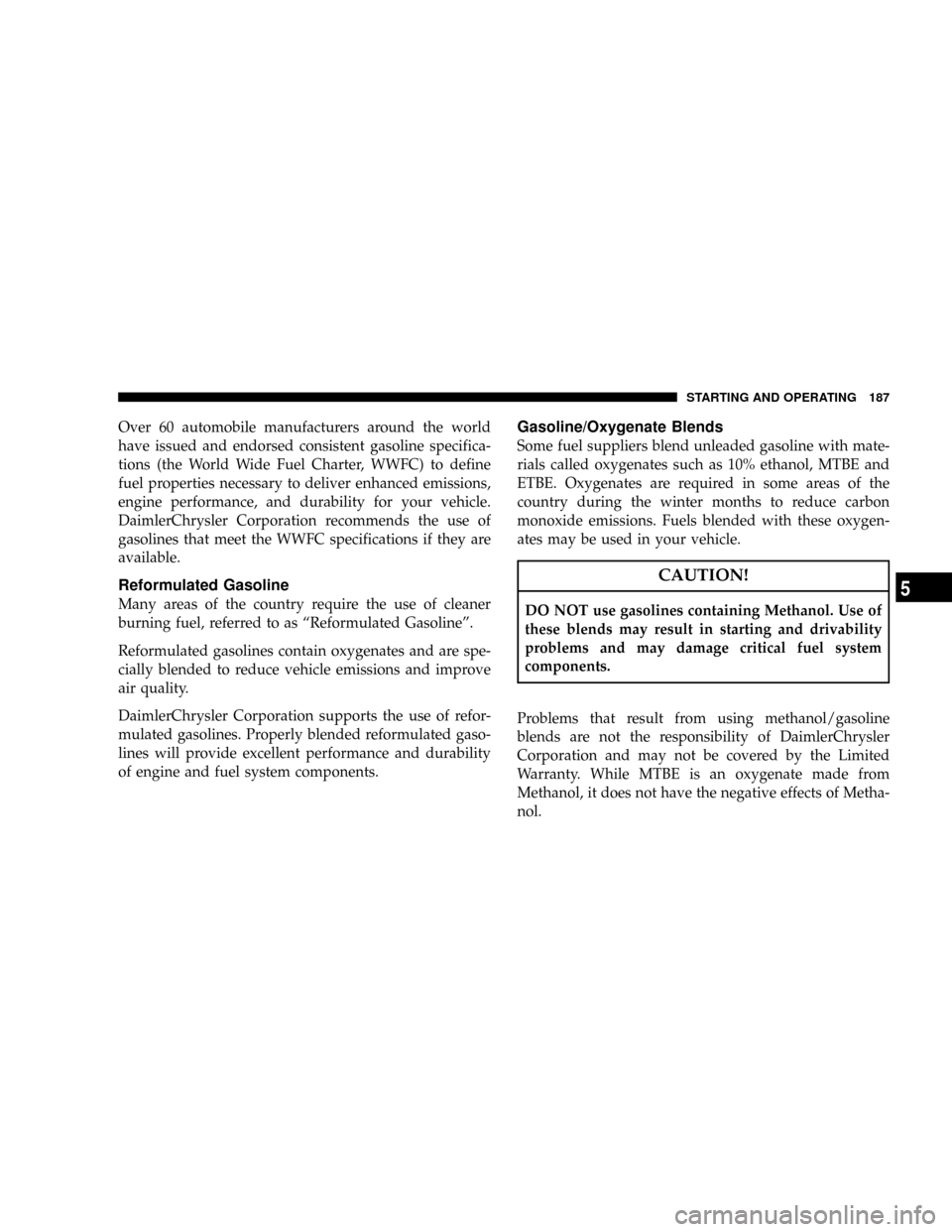
Over 60 automobile manufacturers around the world
have issued and endorsed consistent gasoline specifica-
tions (the World Wide Fuel Charter, WWFC) to define
fuel properties necessary to deliver enhanced emissions,
engine performance, and durability for your vehicle.
DaimlerChrysler Corporation recommends the use of
gasolines that meet the WWFC specifications if they are
available.
Reformulated Gasoline
Many areas of the country require the use of cleaner
burning fuel, referred to as ªReformulated Gasolineº.
Reformulated gasolines contain oxygenates and are spe-
cially blended to reduce vehicle emissions and improve
air quality.
DaimlerChrysler Corporation supports the use of refor-
mulated gasolines. Properly blended reformulated gaso-
lines will provide excellent performance and durability
of engine and fuel system components.
Gasoline/Oxygenate Blends
Some fuel suppliers blend unleaded gasoline with mate-
rials called oxygenates such as 10% ethanol, MTBE and
ETBE. Oxygenates are required in some areas of the
country during the winter months to reduce carbon
monoxide emissions. Fuels blended with these oxygen-
ates may be used in your vehicle.
CAUTION!
DO NOT use gasolines containing Methanol. Use of
these blends may result in starting and drivability
problems and may damage critical fuel system
components.
Problems that result from using methanol/gasoline
blends are not the responsibility of DaimlerChrysler
Corporation and may not be covered by the Limited
Warranty. While MTBE is an oxygenate made from
Methanol, it does not have the negative effects of Metha-
nol.
STARTING AND OPERATING 187
5
Page 188 of 299

MMT in Gasoline
MMT is a manganese containing metallic additive that is
blended into some gasolines to increase the octane num-
ber. Gasolines blended with MMT offer no performance
advantage beyond gasolines of the same octane number
without MMT. Gasolines blended with MMT have shown
to reduce spark plug life and reduce emission system
performance in some vehicles. DaimlerChrysler Corpo-
ration recommends using gasolines without MMT. Since
the MMT content of gasoline may not be indicated on the
pump, you should ask your gasoline retailer whether or
not his/her gasoline contains MMT.
MMT is prohibited in both Federal and California refor-
mulated gasolines.
In Canada, MMT can be used at levels higher than those
allowed in the United States. For this reason, it is even
more important to look for gasolines without MMT in
Canada.
Materials Added to Fuel
All gasoline sold in the United States is required to
contain effective detergent additives. Use of additional
detergents or other additives is not needed under normal
conditions and would result in unnecessary cost. There-
fore, you should not have to add anything to the fuel.
Sulfur in Gasoline
If you live in the Northeast United States, your vehicle
may have been designed to meet California low emission
standards with cleaner burning California reformulated
gasoline with low sulfur. If such fuels are not available in
states adopting California emission standards, your ve-
hicle will operate satisfactorily on fuels meeting Federal
specifications, but emission control system performance
may be adversely affected.
Gasoline sold outside of California is permitted to have
higher sulfur levels, which may affect the performance of
the vehicle's catalytic converter. This may cause the
CHECK ENGINE light to illuminate. DaimlerChrysler
Corporation recommends that you try a different brand
188 STARTING AND OPERATING
Page 189 of 299
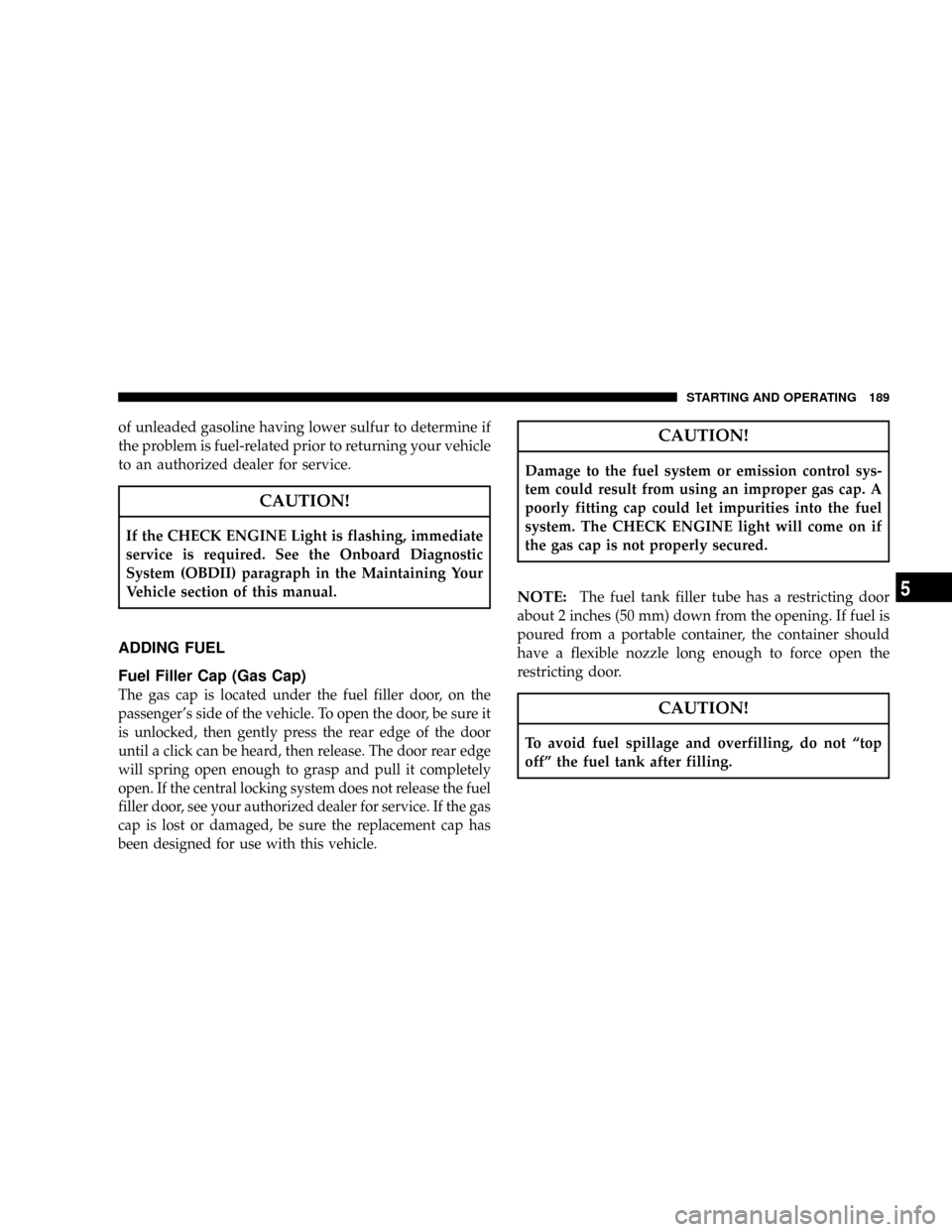
of unleaded gasoline having lower sulfur to determine if
the problem is fuel-related prior to returning your vehicle
to an authorized dealer for service.
CAUTION!
If the CHECK ENGINE Light is flashing, immediate
service is required. See the Onboard Diagnostic
System (OBDII) paragraph in the Maintaining Your
Vehicle section of this manual.
ADDING FUEL
Fuel Filler Cap (Gas Cap)
The gas cap is located under the fuel filler door, on the
passenger's side of the vehicle. To open the door, be sure it
is unlocked, then gently press the rear edge of the door
until a click can be heard, then release. The door rear edge
will spring open enough to grasp and pull it completely
open. If the central locking system does not release the fuel
filler door, see your authorized dealer for service. If the gas
cap is lost or damaged, be sure the replacement cap has
been designed for use with this vehicle.
CAUTION!
Damage to the fuel system or emission control sys-
tem could result from using an improper gas cap. A
poorly fitting cap could let impurities into the fuel
system. The CHECK ENGINE light will come on if
the gas cap is not properly secured.
NOTE:The fuel tank filler tube has a restricting door
about 2 inches (50 mm) down from the opening. If fuel is
poured from a portable container, the container should
have a flexible nozzle long enough to force open the
restricting door.
CAUTION!
To avoid fuel spillage and overfilling, do not ªtop
offº the fuel tank after filling.
STARTING AND OPERATING 189
5
Page 190 of 299
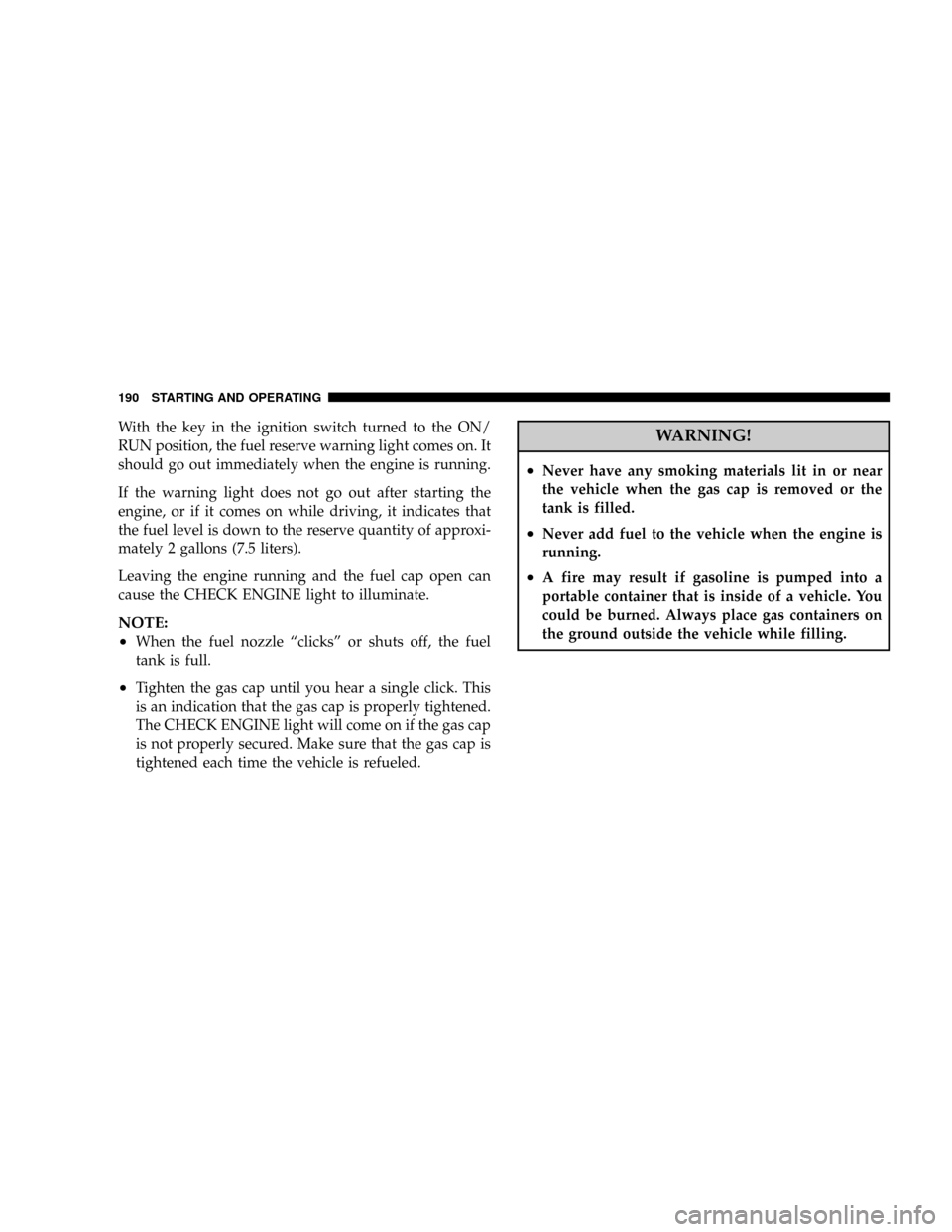
With the key in the ignition switch turned to the ON/
RUN position, the fuel reserve warning light comes on. It
should go out immediately when the engine is running.
If the warning light does not go out after starting the
engine, or if it comes on while driving, it indicates that
the fuel level is down to the reserve quantity of approxi-
mately 2 gallons (7.5 liters).
Leaving the engine running and the fuel cap open can
cause the CHECK ENGINE light to illuminate.
NOTE:
²
When the fuel nozzle ªclicksº or shuts off, the fuel
tank is full.
²Tighten the gas cap until you hear a single click. This
is an indication that the gas cap is properly tightened.
The CHECK ENGINE light will come on if the gas cap
is not properly secured. Make sure that the gas cap is
tightened each time the vehicle is refueled.
WARNING!
²Never have any smoking materials lit in or near
the vehicle when the gas cap is removed or the
tank is filled.
²Never add fuel to the vehicle when the engine is
running.
²A fire may result if gasoline is pumped into a
portable container that is inside of a vehicle. You
could be burned. Always place gas containers on
the ground outside the vehicle while filling.
190 STARTING AND OPERATING
Page 222 of 299
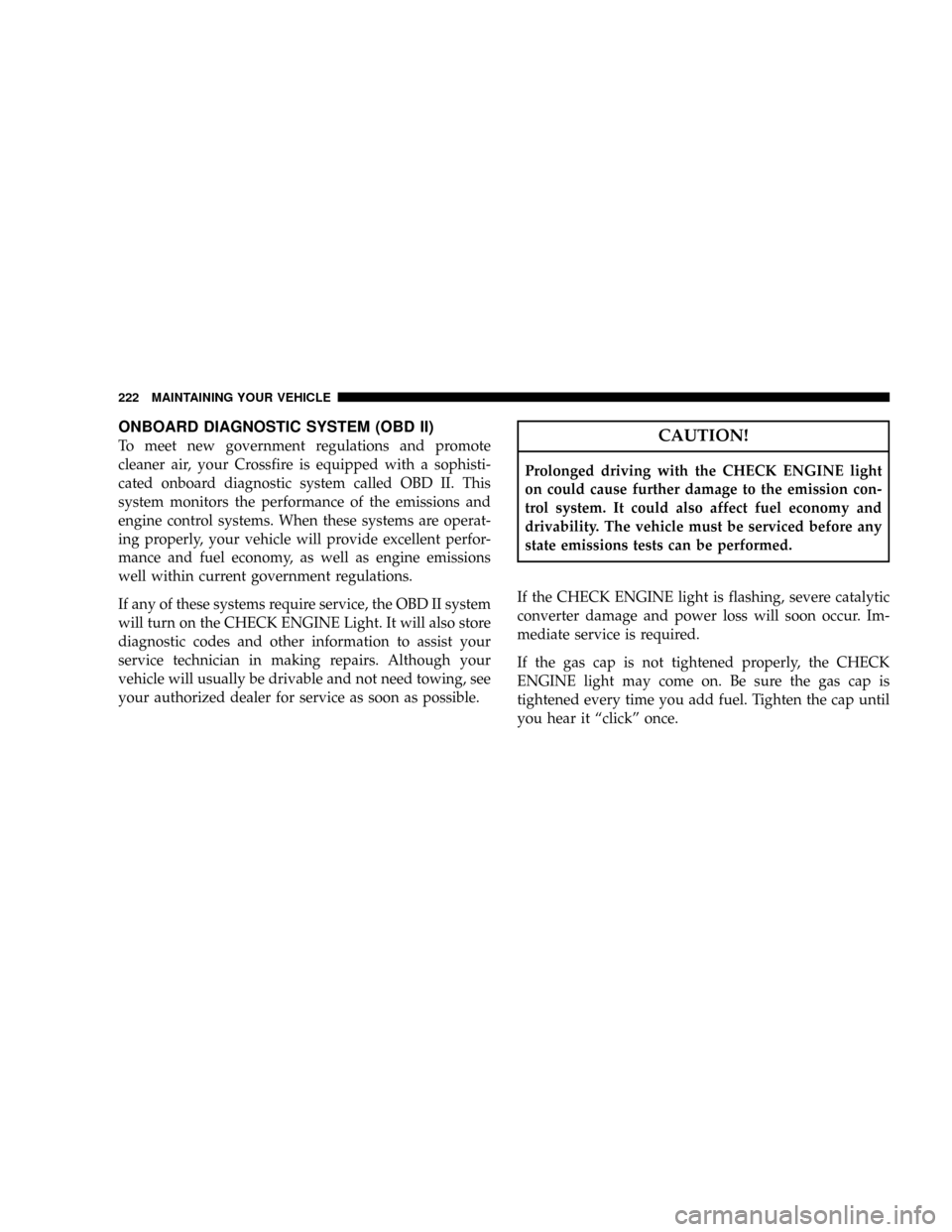
ONBOARD DIAGNOSTIC SYSTEM (OBD II)
To meet new government regulations and promote
cleaner air, your Crossfire is equipped with a sophisti-
cated onboard diagnostic system called OBD II. This
system monitors the performance of the emissions and
engine control systems. When these systems are operat-
ing properly, your vehicle will provide excellent perfor-
mance and fuel economy, as well as engine emissions
well within current government regulations.
If any of these systems require service, the OBD II system
will turn on the CHECK ENGINE Light. It will also store
diagnostic codes and other information to assist your
service technician in making repairs. Although your
vehicle will usually be drivable and not need towing, see
your authorized dealer for service as soon as possible.CAUTION!
Prolonged driving with the CHECK ENGINE light
on could cause further damage to the emission con-
trol system. It could also affect fuel economy and
drivability. The vehicle must be serviced before any
state emissions tests can be performed.
If the CHECK ENGINE light is flashing, severe catalytic
converter damage and power loss will soon occur. Im-
mediate service is required.
If the gas cap is not tightened properly, the CHECK
ENGINE light may come on. Be sure the gas cap is
tightened every time you add fuel. Tighten the cap until
you hear it ªclickº once.
222 MAINTAINING YOUR VEHICLE
Page 225 of 299
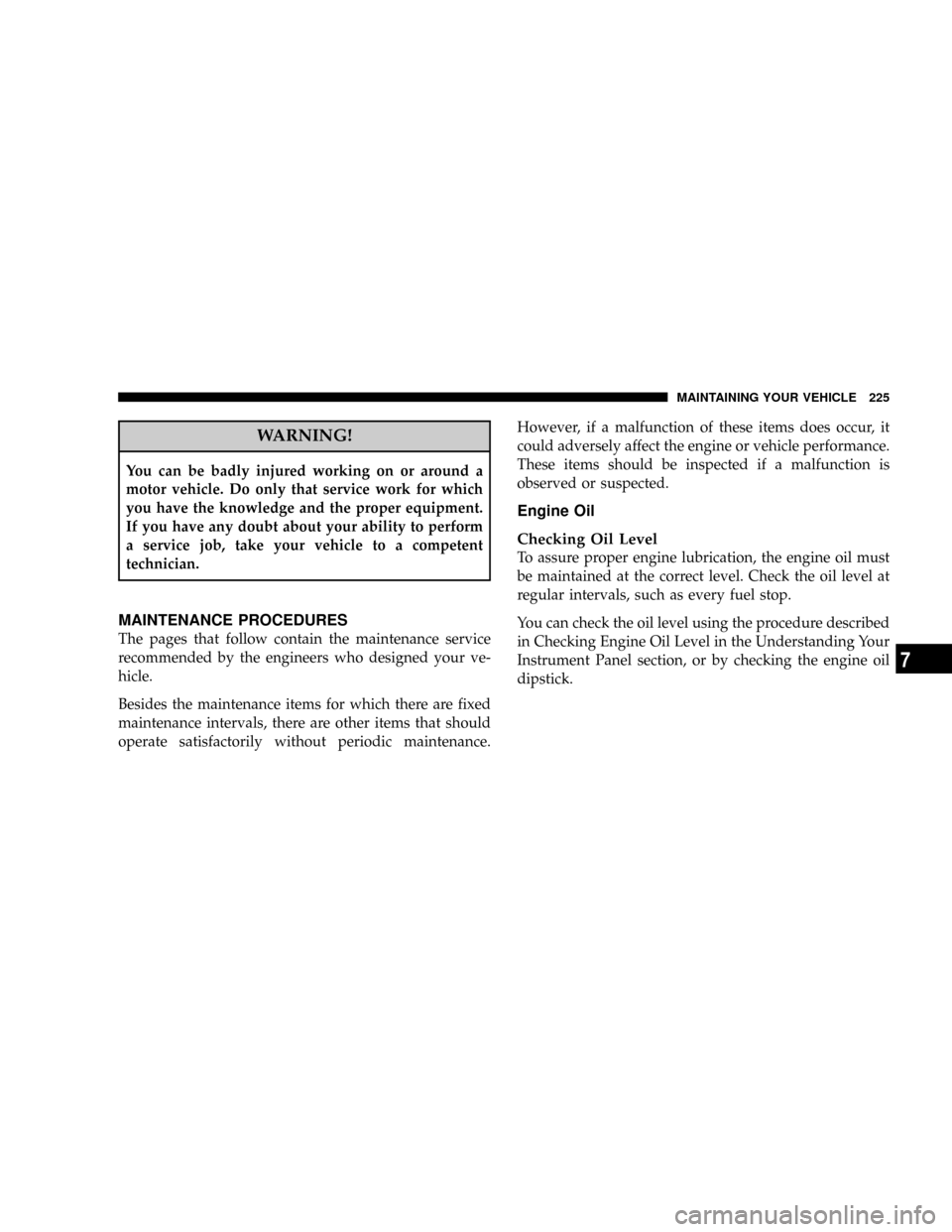
WARNING!
You can be badly injured working on or around a
motor vehicle. Do only that service work for which
you have the knowledge and the proper equipment.
If you have any doubt about your ability to perform
a service job, take your vehicle to a competent
technician.
MAINTENANCE PROCEDURES
The pages that follow contain the maintenance service
recommended by the engineers who designed your ve-
hicle.
Besides the maintenance items for which there are fixed
maintenance intervals, there are other items that should
operate satisfactorily without periodic maintenance.However, if a malfunction of these items does occur, it
could adversely affect the engine or vehicle performance.
These items should be inspected if a malfunction is
observed or suspected.
Engine Oil
Checking Oil Level
To assure proper engine lubrication, the engine oil must
be maintained at the correct level. Check the oil level at
regular intervals, such as every fuel stop.
You can check the oil level using the procedure described
in Checking Engine Oil Level in the Understanding Your
Instrument Panel section, or by checking the engine oil
dipstick.
MAINTAINING YOUR VEHICLE 225
7
Page 229 of 299
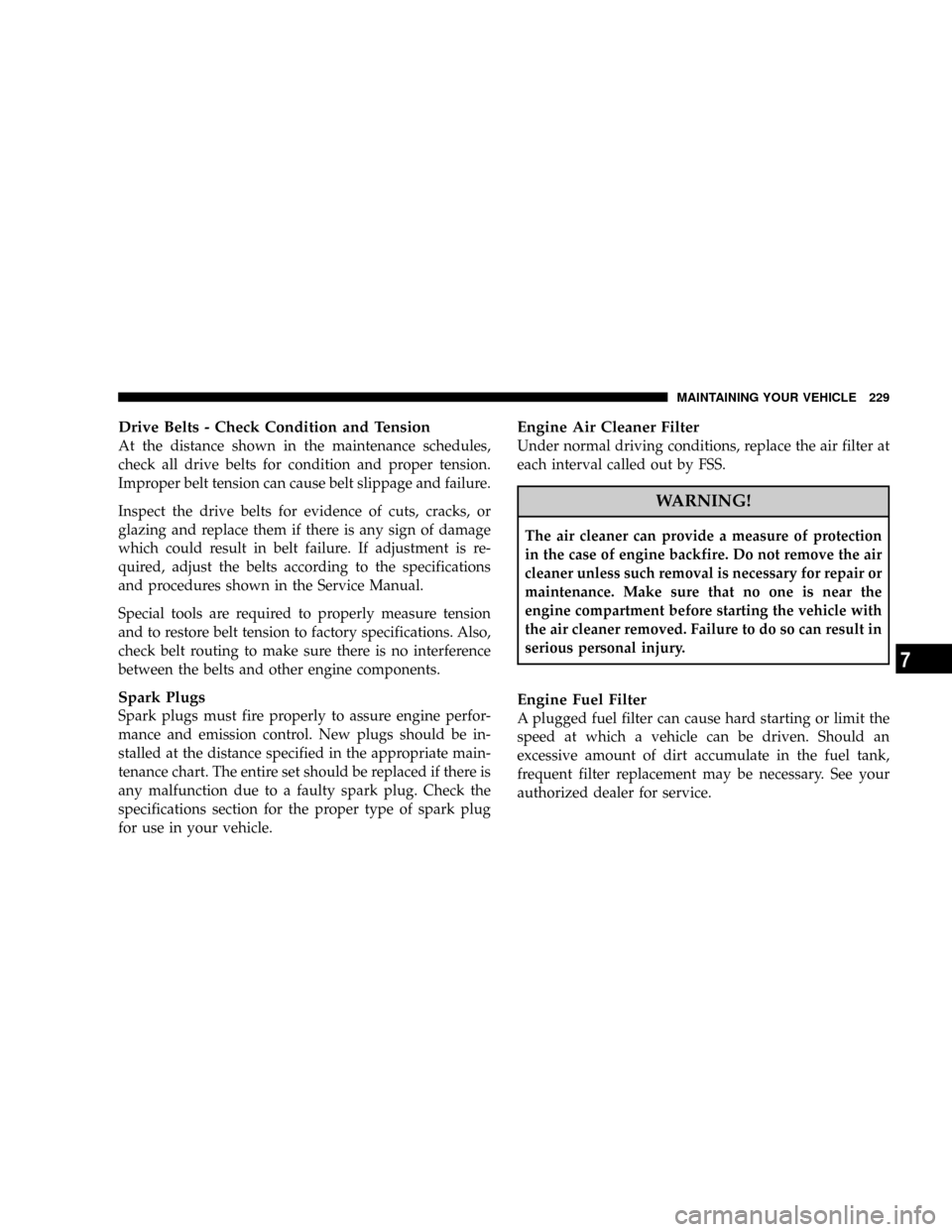
Drive Belts - Check Condition and Tension
At the distance shown in the maintenance schedules,
check all drive belts for condition and proper tension.
Improper belt tension can cause belt slippage and failure.
Inspect the drive belts for evidence of cuts, cracks, or
glazing and replace them if there is any sign of damage
which could result in belt failure. If adjustment is re-
quired, adjust the belts according to the specifications
and procedures shown in the Service Manual.
Special tools are required to properly measure tension
and to restore belt tension to factory specifications. Also,
check belt routing to make sure there is no interference
between the belts and other engine components.
Spark Plugs
Spark plugs must fire properly to assure engine perfor-
mance and emission control. New plugs should be in-
stalled at the distance specified in the appropriate main-
tenance chart. The entire set should be replaced if there is
any malfunction due to a faulty spark plug. Check the
specifications section for the proper type of spark plug
for use in your vehicle.
Engine Air Cleaner Filter
Under normal driving conditions, replace the air filter at
each interval called out by FSS.
WARNING!
The air cleaner can provide a measure of protection
in the case of engine backfire. Do not remove the air
cleaner unless such removal is necessary for repair or
maintenance. Make sure that no one is near the
engine compartment before starting the vehicle with
the air cleaner removed. Failure to do so can result in
serious personal injury.
Engine Fuel Filter
A plugged fuel filter can cause hard starting or limit the
speed at which a vehicle can be driven. Should an
excessive amount of dirt accumulate in the fuel tank,
frequent filter replacement may be necessary. See your
authorized dealer for service.
MAINTAINING YOUR VEHICLE 229
7
Page 230 of 299
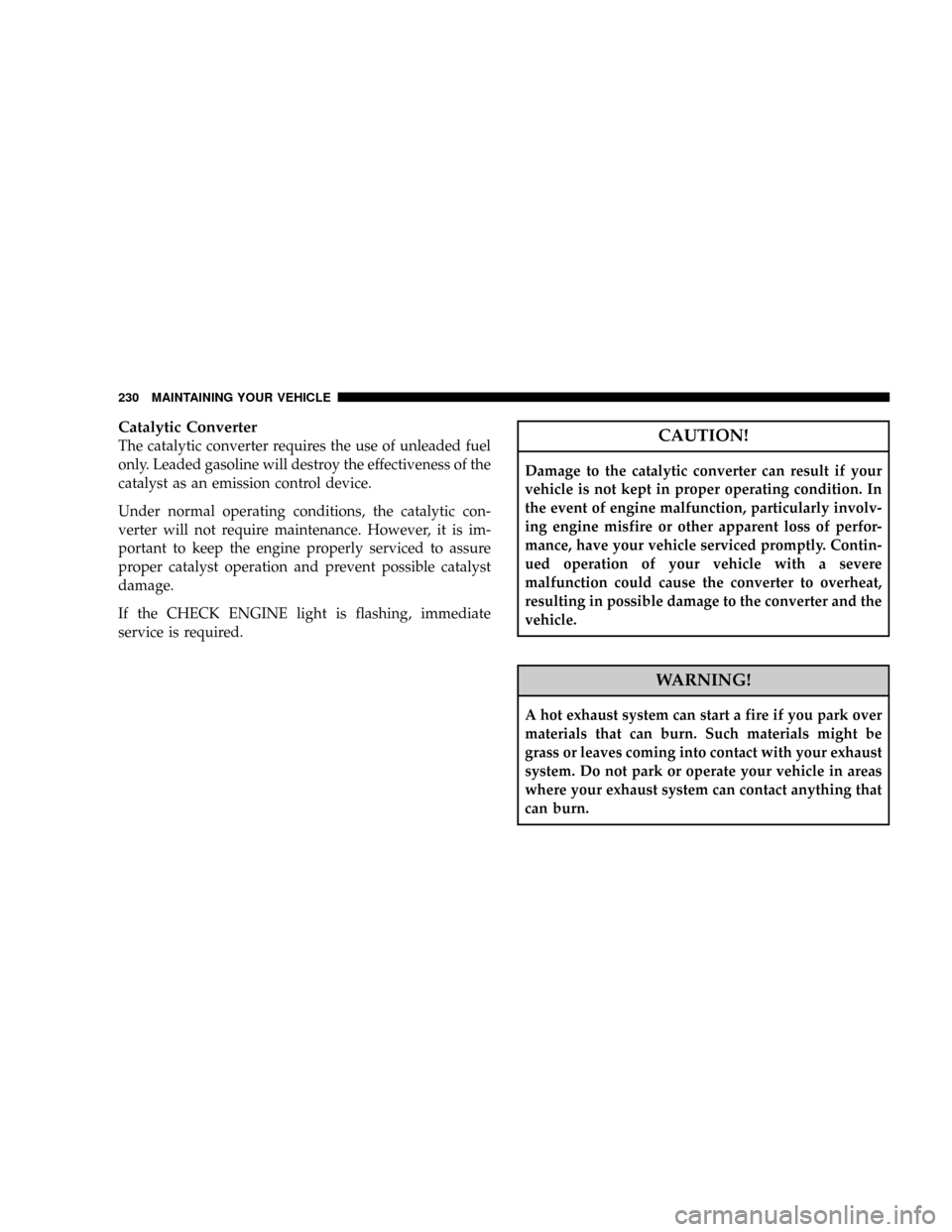
Catalytic Converter
The catalytic converter requires the use of unleaded fuel
only. Leaded gasoline will destroy the effectiveness of the
catalyst as an emission control device.
Under normal operating conditions, the catalytic con-
verter will not require maintenance. However, it is im-
portant to keep the engine properly serviced to assure
proper catalyst operation and prevent possible catalyst
damage.
If the CHECK ENGINE light is flashing, immediate
service is required.CAUTION!
Damage to the catalytic converter can result if your
vehicle is not kept in proper operating condition. In
the event of engine malfunction, particularly involv-
ing engine misfire or other apparent loss of perfor-
mance, have your vehicle serviced promptly. Contin-
ued operation of your vehicle with a severe
malfunction could cause the converter to overheat,
resulting in possible damage to the converter and the
vehicle.
WARNING!
A hot exhaust system can start a fire if you park over
materials that can burn. Such materials might be
grass or leaves coming into contact with your exhaust
system. Do not park or operate your vehicle in areas
where your exhaust system can contact anything that
can burn.
230 MAINTAINING YOUR VEHICLE